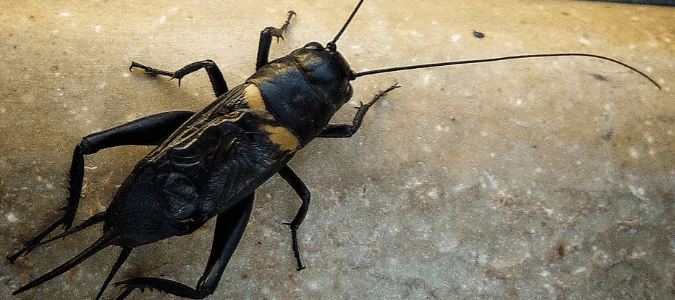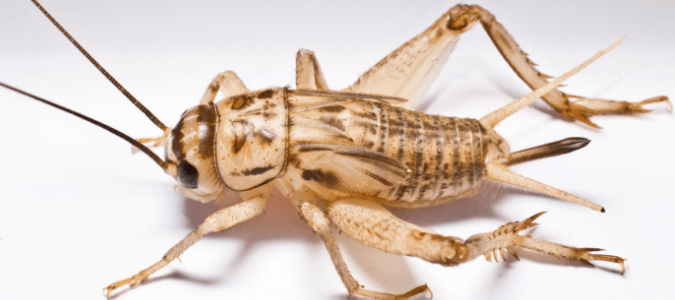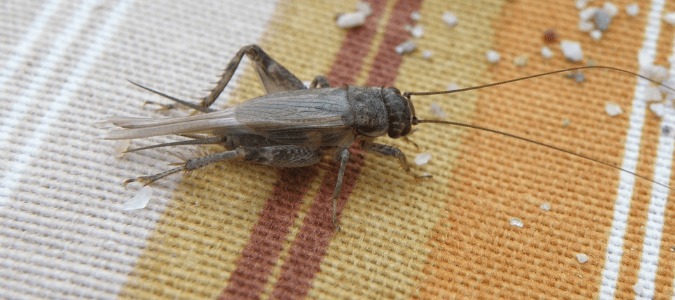
Some years, crickets seem to be everywhere. In late summer and early fall, you might notice an abundance of these insects near your porch lights or hear a chorus of chirping in your backyard at night. If one lands on your leg, you might ask yourself the question: Do crickets bite?
While some species are capable of biting humans, thankfully, this is very unlikely. These insects seem to be more prevalent in years with dry springs and summers, usually appearing in higher numbers in August and September, following rain or cooler weather. Cricket invasions tend to occur when immature crickets go out on nighttime flights in search of mates.
While crickets won’t hurt us, you should know that these creatures can damage your belongings, and can become quite a nuisance. Cricket mandibles can pull fibers loose from carpet and different types of fabric, leaving the surface rough. Also, feces and other bodily fluids can stain wall coverings, drapes and clothing. Crickets are quite hardy, so killing them can be somewhat difficult—especially when these insects occur in large numbers. Since some species produce as many as three generations in a single year, homeowners who take swift action can sometimes prevent an infestation.
Keep reading to learn more about crickets so you know how to deal with a possible infestation and prevent these creatures from becoming a problem.

Black Crickets In House And Other Possible Cricket Invaders
Thankfully, most crickets live outside and only venture indoors when the conditions are extreme, such as during cold weather, or when they are attracted by electric light.
Some of the different types of crickets that you are most likely to see on your property include house crickets, field crickets and camel crickets.
The House Cricket
House crickets are very common in U.S. homes. These insects mostly move indoors in search of a warm, humid place to live during the colder months. Once indoors, they can survive for several months by hiding in closets, crawl spaces and other out-of-the-way spots.
House crickets are:
- Yellowish brown in coloration
- Between 3/4 to 7/8 inches in length
- Winged with large hind legs well-adapted for jumping
While inside a house, house crickets feed on dead insects, indoor plants, clothing and fabrics. As such, house crickets can easily become a bothersome pest—particularly if they multiply, which can happen indoors. Male house crickets make high-pitched chirping sounds to attract females. Consequently, house crickets can become very annoying very quickly.
Field Crickets
Field crickets, or Black crickets, are most commonly found outdoors in agricultural and grassy areas. However, these insects may wander indoors, especially in late fall.
Once inside, field crickets tend to gravitate towards damp areas of your home. They may also hide in damp closets and crawl spaces. However, unlike house crickets, field crickets can’t survive for very long indoors. Most only live for about two weeks before dying.
Field crickets are:
- Black and brown as adults
- Between ½ to 1 inch in length
- Their antennae are longer than their bodies
- Winged with large powerful hind legs
Just like most other cricket species, male field crickets attract females by rubbing their forewings together to produce loud chirping sounds. While these sounds may be tolerant or even pleasant when they are coming from outside the house, this incessant chirping coming from a corner in your bedroom can be maddening.
While field crickets are a species of cricket that is capable of biting a person, this only occurs on extremely rare occasions. Even on these rare occasions, the bite doesn’t pose any significant health threats.
Camel Crickets
Camel crickets have a unique bent body profile which makes them appear “humped”—hence the name “camel cricket.” Some people call these insects cave crickets because they like living in caves and other dark, damp, hidden places. They are also known in some areas as spider crickets.
While camel crickets live outside, they have been known to move indoors if it gets too hot or dry. Once inside, they’ll hide in the moist and dark areas of your house, such as damp corners in your garage, shed, crawl space and closets.
Camel crickets are:
- Light to dark brown with dark bands on their bodies
- Between ½ to 1½ inches in length
- Wingless with large hind legs well-suited for jumping
Unlike the cricket species already described, camel crickets can’t chirp or bite. What they can do, though, is eat away at fabrics and clothing.
Many homeowners have a hard time distinguishing a cricket from a grasshopper or telling one type of cricket from another. A pest control professional can identify your crickets, help you manage an infestation and help you identify home moisture issues to prevent pest problems in the future.

Do Crickets Fly?
You might have noticed wings when you had a close encounter with a cricket on your back porch. This begs an important question: can crickets fly?
Some field and house crickets do have fully-formed, fully-functional wings. These crickets often use these wings to fly towards light sources at night.
However, the vast majority of the more than 100 cricket species found in the U.S. can’t fly. And while it’s shocking when you see these pests jump from place to place, most homeowners would choose this type of creature over a jumping spider.
Crickets primarily use their wings to communicate. Those characteristic chirping sounds are created when crickets rub their wings or legs together. This is how they communicate, particularly during mating season. It’s easy to understand why you might think all crickets can fly because they’re excellent jumpers and know how to use their wings to stay airborne over short distances following each jump. This cricket behavior is closer to “gliding” than actual “flying,” however.

What Do Crickets Eat?
All cricket species are omnivorous, meaning they eat plants as well as animals.
In the wild, crickets will eat rotting plant matter and munch on tender leaves and plant shoots. You may also see a cricket prey on other insects and bugs. When food is scarce, some crickets even turn to cannibalism and eat other, weaker crickets.
As you can probably tell, crickets aren’t very discriminating about what they eat. So, when a cricket invades your house, you should be prepared for this invader to chew on many different items. When you think about it, there’s quite a lot that crickets can chew on inside your home, thanks to their strong mandibular mouthparts.
Crickets can eat leftovers and food dropped on tables, floors and kitchen counters. These insects can also find their way into your pet’s feeding bowl and eat your pet’s food. You may even catch these creatures gnawing at exposed fruits, vegetables and other food that is left out.
When a cricket can’t find enough food in your house, non-food items such as paper products, clothing, fabrics and furniture are an easy target. Crickets seem especially drawn to soiled and perspiration-stained clothes.
Now that you know a little more about crickets and the damage they can do in your home, let’s discuss how to evict these unwelcome houseguests.

How To Get Rid Of Crickets In A House
Once these crickets have found their way indoors, how do you get rid of them? While some homeowners prefer using a fly swatter or shoe, the easiest way to remove crickets is with the vacuum cleaner. Just make sure to empty your vacuum bag promptly in your outdoor trash so a dead cricket does not attract other insects. There are a number of other methods that have shown to have varying degrees of effectiveness.
Sticky Traps
You can place sticky traps around your home in hopes that a cricket will walk or jump onto them and get stuck. This tactic works better with camel crickets.
Diatomaceous Earth (DE)
This fine, white powder is actually tiny bits of fossil shells. When applied between your walls and in areas crickets walk during the day, this substance can damage the insect’s exoskeleton, eventually leading to its death. When you apply Diatomaceous earth, just be sure to wear a dust mask so you don’t accidentally inhale the powder.
Natural Predators
While this will not help with an infestation, cats can help manage an indoor cricket population. Other creatures that may prey on crickets include lizards, birds and spiders, so making your yard more inviting to these animals can help control crickets naturally.
Contact A Pest Professional
While some over the counter baits are effective, if your infestation is particularly bad, your best bet is to bring in an experienced pest control company to recommend a treatment plan.
How To Keep Crickets Away
After your resident crickets are gone, here’s what you can do to prevent subsequent cricket invasions:
- Keep your kitchen and anywhere human or animal food is consumed in your home clean, making sure containers are tightly sealed.
- Seal all cracks and crevices around the house through which crickets may gain entry.
- Get rid of fallen leaves and reduce the use of mulches around entryways and house foundations.
- Reduce outdoor lighting, as bright lights tend to attract crickets.
- Mow your lawn regularly.
- Remove moisture sources by repairing leaks and improving ventilation in crawl spaces and other cool, damp areas.
- Elevate garbage cans above the ground.
- Close doors and windows at all times, especially when crickets are most active.
ABC Can Handle Any Pest Problem
These do-it-yourself methods require time and effort on your part, and most of the time they keep a cricket population from growing, but won’t get rid of these pests entirely. Calling in a professional from ABC Home & Commercial Services is your best bet for controlling and removing these insects and preventing future problems. With ABC’s help, you won’t have to worry about crickets or any other pests that invade your home.
